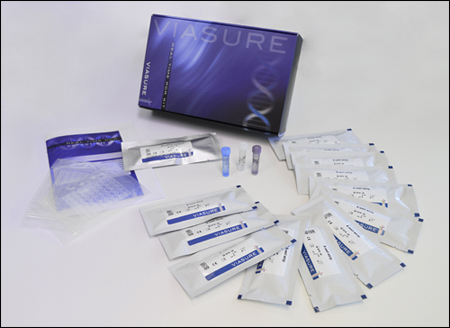
VIASURE Real Time PCR Detection Kits
Tick Borne Diseases (3 wells): (Borrelia, Anaplasma & C. burnetii) + (Rickettsia, Babesia & Ehrlichia) + (TBEV)

Description
VIASURE Tick Borne Diseases Real Time PCR Detection Kit is a real-time RT-PCR test designed for the qualitative detection of viral RNA or genomic DNA specific for Tick Borne Encephalitis Virus (TBEV), Rickettsia spp., Babesia microti/Babesia divergens, Ehrlichia chafeensis/Ehrlichia muris, Borrelia burgdorferi sensu lato (s.l.)/Borrelia miyamotoi/Borrelia hermsii, Anaplasma phagocitophylum and/or Coxiella burnetii in clinical samples from patients with signs and symptoms compatible with Tick Borne diseases such as biopsy skin, cerebrospinal fluid (CSF) and synovial fluid and clinical samples for epidemiological surveillance and control such as blood, serum, tissue samples and microbiological culture from ticks.
This test is intended for use as an aid in the diagnosis of Tick Borne diseases in combination with clinical and epidemiological risk factors. This test is not designed to diagnose Lyme disease, it detects but not differentiate Borrelia burgdorferi sensu lato (s.l.), Borrelia miyamotoi and Borrelia hermsii.
RNA/DNA is extracted from clinical specimens, multiplied using Real Time amplification and detected using fluorescent reporter dye probes specific TBEV, Rickettsia spp., Babesia microti, Babesia divergens, Ehrlichia chafeensis, Ehrlichia muris, Borrelia burgdorferi sensu lato s.l., Borrelia miyamotoi and Borrelia hermsii, Anaplasma phagocitophylum and Coxiella burnetii.
Specifications
Information
Ticks transfer pathogens from their gut to the host bloodstream by their saliva (Garcia et al., 2022) causing the Tick Borne diseases (TBDs).The incidence and geographic distribution of Tick-borne diseases (TBDs) have been steadily increasing over the past few decades, leading to substantial morbidity and occasionally mortality in affected individuals (Rowan et al., 2023). Tick Borne diseases affecting humans include Lyme disease, relapsing fever, babesiosis, anaplasmosis, ehrlichiosis, Q fever, Tick Borne encephalitis and spotted fever among others.
Tick-borne encephalitis virus (TBEV) a member of the family Flaviviridae (WHO, 2024), is transmitted primarily by ticks of the genus Ixodes. TBEV is an important cause of viral infections of the central nervous system in eastern, central, northern and increasingly western European countries, and in northern China, Mongolia, and the Russian Federation.
Rickettsiae are obligate intracellular Gram-negative bacteria, transmitted via an arthropod vector (tick, fleas, lice or mites) from wild or domestic vertebrate hosts (Stewart et al., 2021). Rickettsial infections occur worldwide, with the geographic distribution of each species dependent on the vector, natural host, and climate (Stewart et al., 2021). The different species Rickettsia give rise to a wide spectrum of disease, from a self-limiting febrile illness to life-threatening, multi-organ failure (Stewart et al., 2021).
Human babesiosis is a zoonotic infection caused by Babesia parasites transmitted by the bite of ticks of the genus Ixodes that have distinct geographical distributions based on the presence of their competent natural animal hosts, which include rodents, cattle and deer. The genus Babesia comprises many species of parasites, which are transmitted when the ticks takes a blood meal from the vertebrate host.(Louise Ord & Lobo, n.d.)
Most human babebioses may be asymptomatic, especially in younger or immune competent individuals, and the burden of severe pathology resides within older or immunocompromised individuals, as well as in transfusion-transmitted babesiosis since asymptomatic carriers donate blood and do not yet no licensed or regulated tests to screen blood products for this pathogen. In addition, new Babesia spp. have been identified globally as agents of severe human babesiosis (Louise Ord & Lobo, n.d.). With the use of molecular techniques made it easy to study the evolution of parasites and thereby reclassifying Babesia spp. (Laha et al., 2015).
“Ehrlichiosis” is a generic name for infections caused by obligate intracellular bacteria in the family Anaplasmataceae, chiefly in the genera Ehrlichia and Anaplasma. (Dumler et al., 2007). They are transmitted by ticks and cause flu-like symptoms such as fever, muscle aches, and headache. It may take up to 14 days after a tick bite to begin showing signs and symptoms of ehrlichiosis and anaplasmosis. Untreated ehrlichiosis and anaplasmosis can result in serious or life-threatening complications.
Lyme borreliosis (Lyme disease) is caused by spirochaetes of the Borrelia burgdorferi sensu lato species complex, which are transmitted by ticks. Most common clinical manifestation is erythema migrans, which eventually resolves, even without antibiotic treatment. However, the infecting pathogen can spread to other tissues and organs, causing more severe manifestations that can involve a patient’s skin, nervous system, joints, or heart. The incidence of this disease is increasing in many countries.
Coxiella burnetii is an obligate intracellular, pleomorphic gram-negative rod-shaped bacteria that causes Q fever. Q fever can present as a febrile illness, pneumonia, or hepatitis. If it is not appropriately treated, it can lead to complications such as osteomyelitis, endocarditis, and vascular infections. It is, therefore, important to promptly identify and treat this condition. (Neupane et al. 2023)
Currently, there are no standardized multiplex molecular diagnostics assays that are commercially available for tick-borne diseases. Nucleic acid multiplex molecular diagnostic tools will thus be of paramount importance in controlling the disease spread and can be used as an effective tool for surveillance studies. (Garcia et al., 2022)
